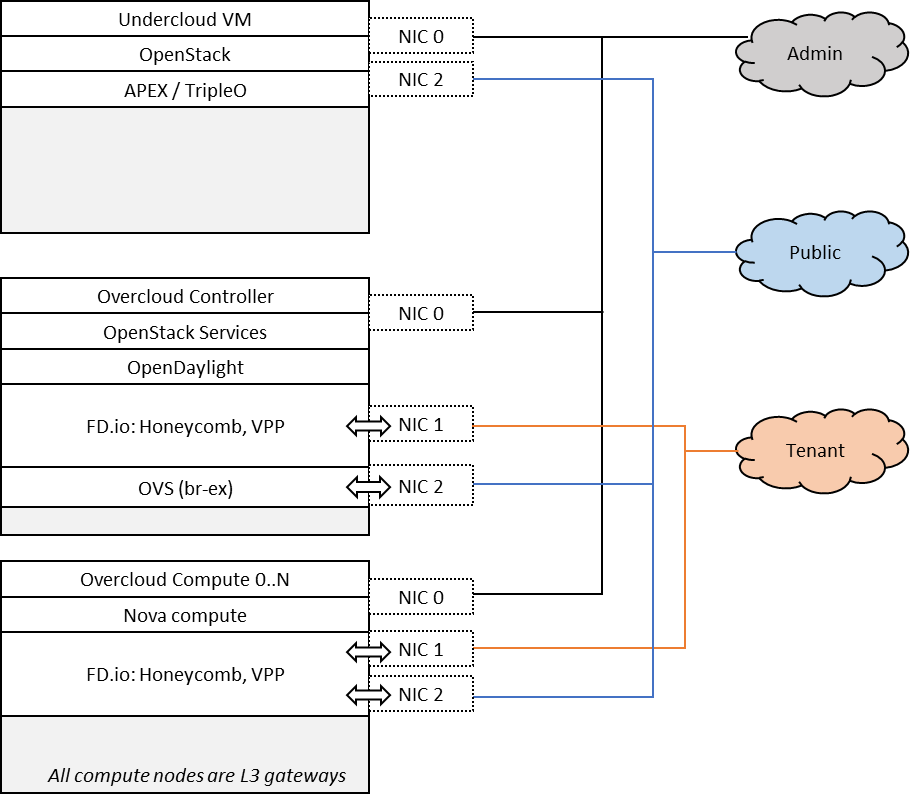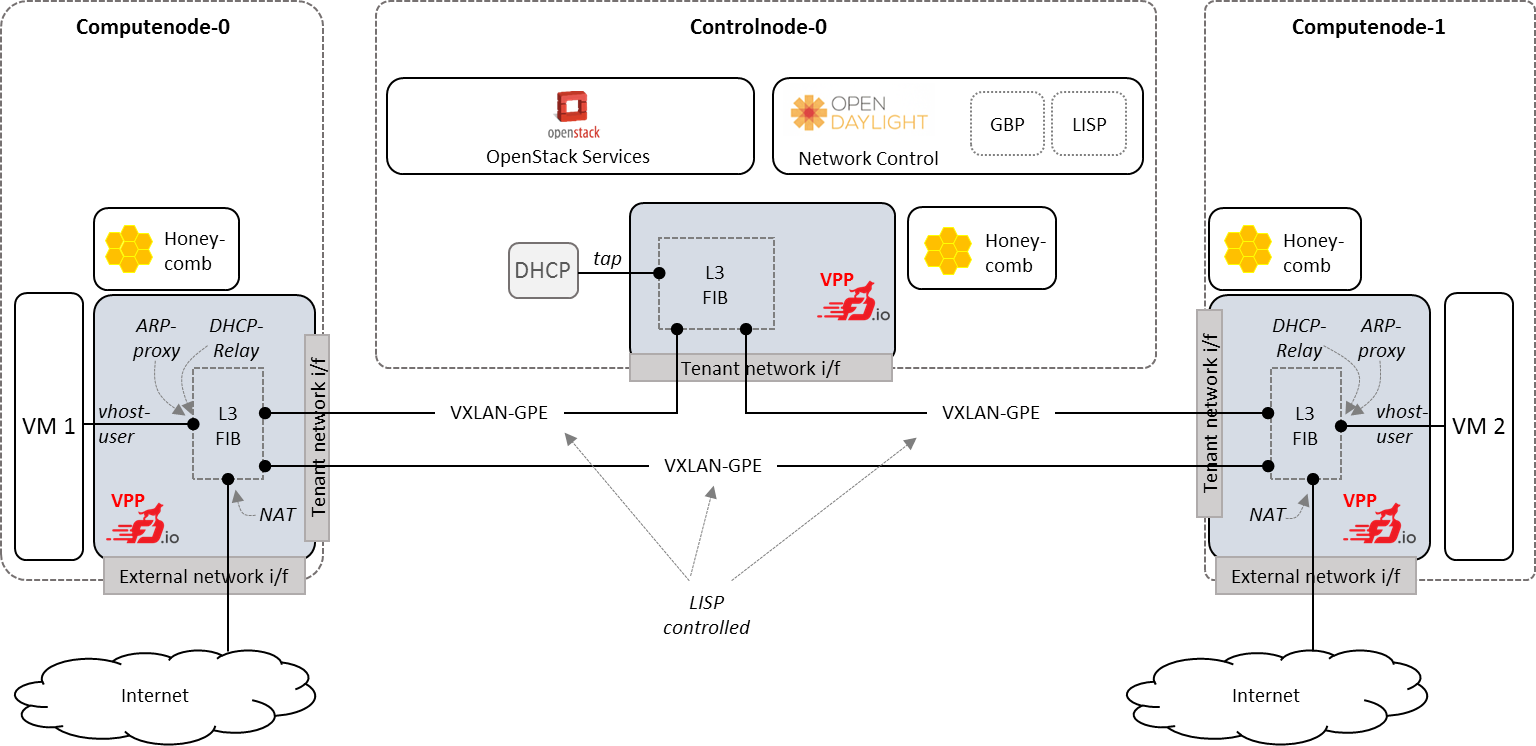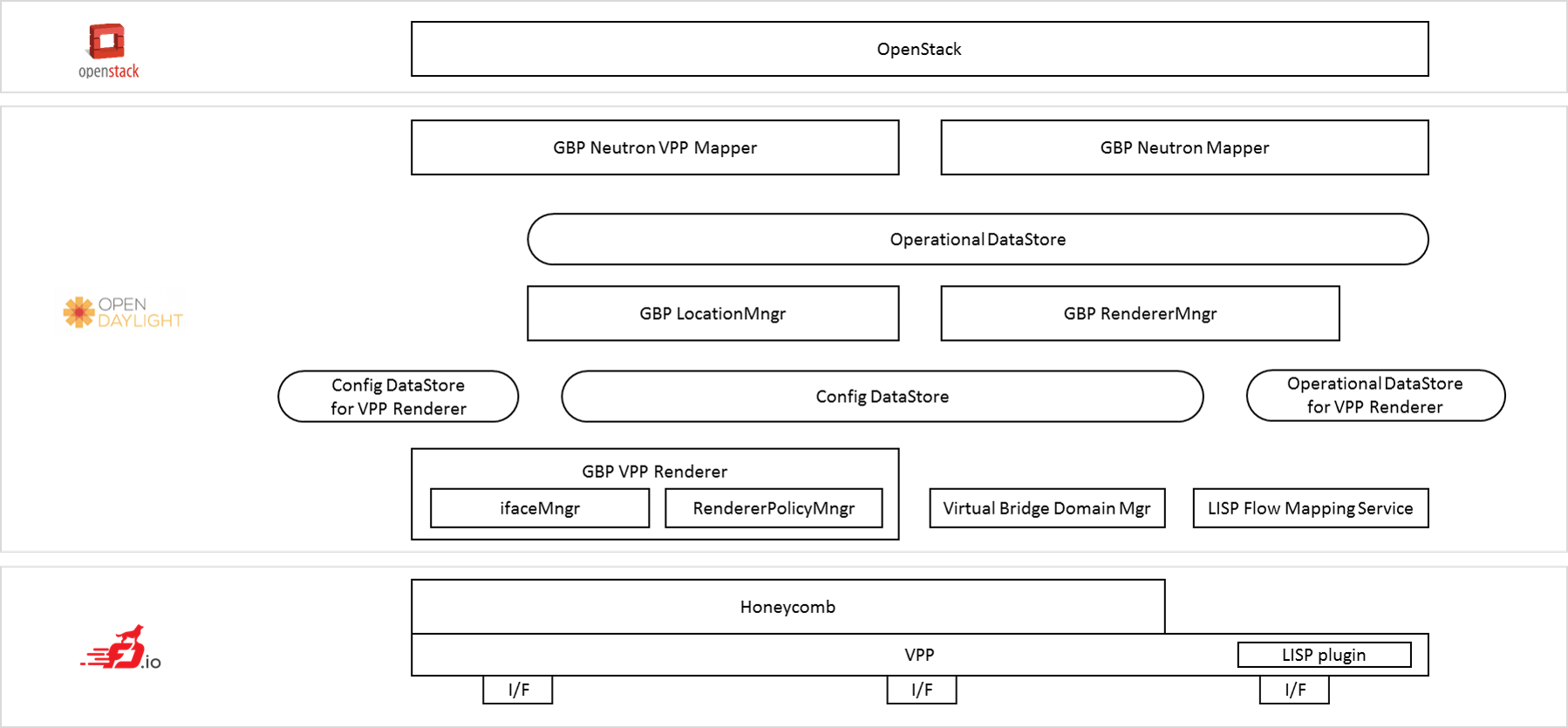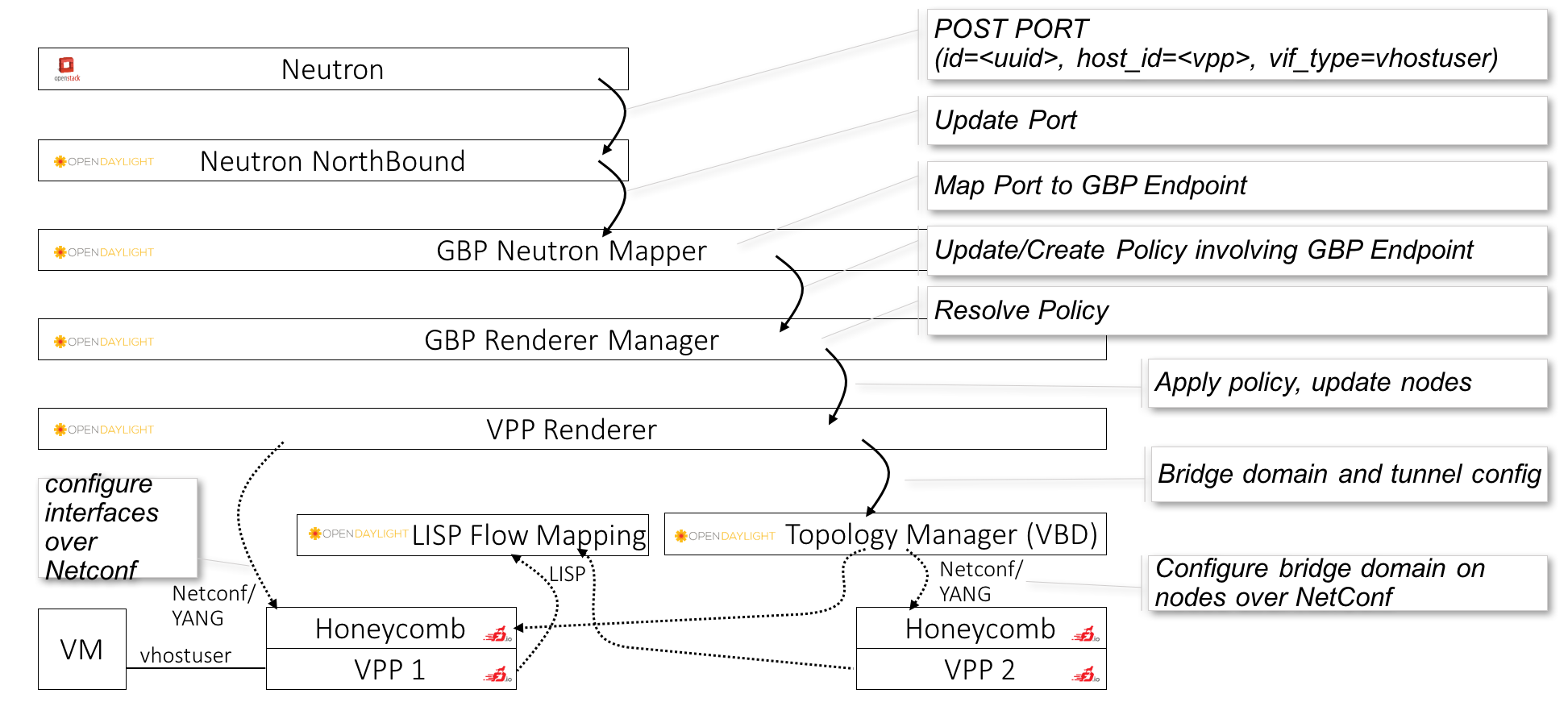Fast Data Stacks Scenario: os-odl-fdio-dvr-noha Overview and Description¶
Scenario: “OpenStack - Opendaylight - FD.io DVR” (apex-os-odl-fdio-dvr-noha) is a scenario developed as part of the FastDataStacks OPNFV project.
1. Scenario: “OpenStack - OpenDaylight - FD.io DVR”¶
Scenario: apex-os-odl-fdio-dvr-noha
“apex-os-odl-fdio-dvr-noha” is a scenario developed as part of the FastDataStacks OPNFV project. The main components of the “apex-os-odl-fdio-dvr-noha” scenario are:
- APEX (TripleO) installer (please also see APEX installer documentation)
- Openstack (in non-HA configuration)
- OpenDaylight controller (non-clustered) controlling networking
- FD.io/VPP virtual forwarder for tenant and public networking; the virtual forwarder serves as layer 3 forwarder on each compute node, providing high availability of layer 3 services
2. Introduction¶
NFV and virtualized high performance applications, such as video processing, require a “fast data stack” solution that provides both carrier grade forwarding performance, scalability and open extensibility, along with functionality for realizing application policies and controlling a complex network topology.
A solution stack is only as good as its foundation. Key foundational assets for NFV infrastructure are
- The virtual forwarder: The virtual forwarder needs to be a feature rich, high performance, highly scale virtual switch-router. It needs to leverage hardware accelerators when available and run in user space. In addition, it should be modular and easily extensible.
- Forwarder diversity: A solution stack should support a variety of forwarders, hardware forwarders (physical switches and routers) as well as software forwarders. This way virtual and physical forwarding domains can be seamlessly glued together.
- Policy driven connectivity: Connectivity should respect and reflect different business policies
In order to meet the desired qualities of an NFV infrastructure, the following components were chosen for the “Openstack - OpenDaylight - FD.io” scenario:
- FD.io Vector Packet Processor (VPP) - a highly scalable, high performance, extensible virtual forwarder providing fully distributed routing on each compute node
- OpenDaylight Controller - an extensible controller platform which offers the ability to separate business logic from networking constructs, supports a diverse set of network devices (virtual and physical) via the “Group-Based Policy (GBP)” component, and can be clustered to achieve a highly available deployment.
The “Openstack - OpenDaylight - FD.io DVR” scenario provides the capability to realize a set of use-cases relevant to the deployment of NFV nodes instantiated by means of an Openstack orchestration system on FD.io/VPP enabled controller and compute nodes, with computes nodes being the hosts for distributed virtual routing. Distributed virtual routing enables all forwarding operations to be available locally on each compute node, removing scaling issues and performance bottlenecks. In addition, the forwarding setup is highly available since a failure on a given compute node is local to that node and doesn’t affect routing anywhere else. The role of the Opendaylight network controller in this integration is twofold. It provides a network device configuration and topology abstraction via the Openstack Neutron interface, while providing the capability to realize more complex network policies by means of Group Based Policies. Furthermore it also provides the capabilities to monitor as well as visualize the operation of the virtual network devices and their topologies. In supporting the general use-case of instantiatiting an NFV instance, VXLAN GPE overlay encapsulation transport network is used.
A deployment of the “apex-os-odl-fdio-dvr-noha” scenario consists of 4 or more servers:
1 Jumphost hosting the APEX installer - running the Undercloud
- 1 Controlhost, which runs the Overcloud as well as
OpenDaylight as a network controller
2 or more Computehosts. These Computehosts also serve as layer 3 gateways for tenant networks and provide ditributed virtual routing

Tenant and public networking leverages FD.io/VPP. On compute nodes, VPP binds to both the tenant networking interface as well as the public networking interface. This means that VPP is used for communication within a tenant network, between tenant networks, as well as between a tenant network and the Internet.
Note that this setup differs from the usual centralized layer 3 setup with qrouter on a controller node. There is no layer 2 networking. The OpenDaylight network controller is used to setup and manage layer 3 networking for the scenario, with Group Based Policy (GBP) and Locator/Identifier Separation Protocol (LISP) Flow Mapping Service being the key components. Tenant networking leverages VXLAN GPE encapsulation, where LISP Flow Mapping Service and the LISP protocol in VPP create tunnels between nodes where it’s required, providing dynamic, fail-safe connectivity between nodes and obviating the need for full mesh maintanance and monitoring.
The picture below shows an example setup with two compute and one controller nodes. Note that the external network is connected via each compute node through VPP, providing full distributed routing. VPP provides almost all layer 3 services which are provided in a “vanilla” OpenStack deployment, including one-to-one NAT but not source NAT, as well as north-south and east-west traffic filtering for security purposes (“security groups”).

3. Features of the scenario¶
Main features of the “apex-os-odl-fdio-dvr-noha” scenario:
- Automated installation using the APEX installer
- Fast and scalable tenant networking using FD.io/VPP as forwarder
- Layer 3 tenant networking using VXLAN GPE, managed and controlled through OpenDaylight and LISP protocol in FD.io/VPP
- Layer 3 connectivitiy for tenant networks supplied through FD.io/VPP. Layer 3 features, including security groups as well as floating IP addresses (i.e. NAT) are implemented by the FD.io/VPP forwarder
- Manual and automatic (via DHCP relaying) addressing on tenant networks
4. Scenario components and composition¶
The apex-os-odl-fdio-dvr-noha scenario combines components from three key open source projects: OpenStack, OpenDaylight, and Fast Data (FD.io). The key components that realize the apex-os-odl-fdio-dvr-noha scenario and which differ from a regular OVS-based scenario are the OpenStack ML2 OpenDaylight plugin, OpenDaylight Neutron Northbound, OpenDaylight Group Based Policy, OpenDaylight Locator/Identifier Separation Protocol Flow Mapping Service, FD.io Honeycomb management agent and FD.io Vector Packet Processor (VPP).
Here’s a more detailed list of the individual software components involved:
Openstack Neutron ML2 OpenDaylight Plugin: Handles Neutron data base synchronization and interaction with the southbound controller using a REST interface.
ODL GBP Neutron Mapper: Maps neutron elements like networks, subnets, security groups, etc. to GBP entities: Creates policy and configuration for tenants (endpoints, resolved policies, forwarding rules).
ODL GBP Neutron VPP Mapper: Maps Neutron ports to VPP endpoints in GBP.
ODL GBP Location Manager: Provides real location for endpoints (i.e. Which physical node an endpoint is connected to).
GBP Renderer Manager: Creates configuration for Renderers (like e.g. VPP-Renderer or OVS-Renderer). The GBP Renderer Manager is the central point for dispatching of data to specific device renderers. It uses the information derived from the GBP end-point and its topology entries to dispatch the task of configuration to a specific device renderer by writing a renderer policy configuration into the registered renderer’s policy store. The renderer manager also monitors, by being a data change listener on the VPP Renderer Policy States, for any errors in the application of a rendered configuration.
GBP VPP Renderer Interface Manager: Listens to VPP endpoints in the Config DataStore and configures associated interfaces on VPP via HoneyComb.
LISP Flow Mapping Service: Stores location information for tenant VMs, where the location is the IP address of the compute host running the VM, represented as a LISP Routing Locator (RLOC) and the tenant VM address is represented as a LISP Endpoint Identifier (EID). The above information is stored in an EID-to-RLOC database maintained by the Service, added by the LISP VPP component through the LISP Plugin, and is made available for retrieval to any compute node. Implements a pub/sub mechanism, where changes in a mapping are notified to data forwarders which have previously asked for that particular mapping.
LISP Plugin: Implements the LISP control protocol and is responsible for receiving/sending UDP LISP control packets on the cloud (compute/controller) network, translating them to/from YANG modeled data structures used in OpenDaylight, and passing/getting those structures to/from the LISP Flow Mapping Service.
Virtual Packet Processor (VPP): The VPP is the accelerated data plane forwarding engine relying on vhost user interfaces towards Virtual Machines created by the Nova Agent.
VPP LISP: Creates traffic driven dynamic tunnels between compute nodes, encapsulating tenant VM traffic with VXLAN GPE, using mapping information from the LISP Flow Mapping Service. It is also registering mapping information about VMs on its host compute (or controller) node to the same service.
Honeycomb Netconf server: The Honeycomb NETCONF configuration server is responsible for driving the configuration of the VPP, and collecting operational data.
Nova Agent: The Nova Agent, a sub-component of the overall Openstack architecture, is responsible for interacting with the compute node’s host Libvirt API to drive the life-cycle of Virtual Machines. It, along with the compute node software, are assumed to be capable of supporting vhost user interfaces.
The picture below shows the key components.

5. Neutron Port Callflow¶
When a port is created or updated, Neutron sends data to ODL Neutron Northbound which contain UUID, along with a host-id such as “overcloud-novacompute-0.opnfv.org” and vif-type as “vhost-user”. The GBP Neutron mapper turns the “Neutron speak” of “ports” into the generic connectivity model that GroupBasedPolicy uses. Neutron “ports” become generic “GBP Endpoints” which can be consumed by the GBP Renderer Manager. The GBP Renderer Manager resolves the policy for the endpoint, i.e. it determines which communication relationships apply to the specific endpoint, and hands the resolution to a device specific renderer, which is the VPP renderer in the given case here. VPP renderer turns the generic policy into VPP specific configuration. Note that in case the policy would need to be applied to a different device, e.g. an OpenVSwitch (OVS), then an “OVS Renderer” would be used.
VPP Renderer communicated with the device using Netconf/Yang. All compute and controller nodes run an instance of VPP and the VPP-configuration agent “Honeycomb”. Honeycomb serves as a Netconf/YANG server, receives the configuration commands from VBD and VPP Renderer and drives VPP configuration using VPP’s local Java APIs.
The network configuration rendered to VPP sets up Proxy-ARP, a destination to be used for north-south packet flow, the address of OpenDaylight and for each VM, a mapping from the tenant VM address to VPP’s own addres (compute node), used for east-west traffic. These mappings are periodically sent by VPP LISP using the LISP protocol through the LISP Plugin to the LISP Flow Mapping Service. Mappings are retrieved on-demand and cached by VPP LISP for VMs on other compute nodes, when traffic exists.
To provide a better understanding how the above mentioned components interact with each other, the following diagram shows how the example of creating a vhost-user port on VPP through Openstack Neutron:

6. DHCP Packet Flow¶
DHCP traffic from a VM first arrives at vhost-user port in VPP, which is configured as unnumbered with ip of loopback interface (which corresponds with tenant interface port) for the VRF where the VM resides. DHCP proxy is configured to relay DHCP packets to the DHCP server created by neutron-dhcp-agent running on the node where the VM was created. DHCP relay sets the destination ip to the ip of the DHCP server and source ip to the loopback ip. Opendaylight configures a route for the DHCP server, sending packets to the tap port which is connected to the DHCP namespace.
7. East-West Packet Flow¶
Suppose we have VM1 on compute1 sending traffic to VM2 on compute2. This traffic will flow according to the rules in the forwarding information bases (FIBs) in the VPP processes on the compute nodes. The L3 destination on the packets is the tenant address of VM2, and VM1 does ARP resolution for the subnet gateway address for the L2 destination. The Proxy-ARP service from VPP on compute1 replies with the MAC address of itself, so it can intercept the packet.
Once the packet reaches VPP, it is sent to the VPP LISP component for processing (the default action when LISP is enabled), which performs a mapping lookup using a Map-Request LISP control packet sent to ODL. At this point, the packet is dropped, because no buffering is performed for data plane packets without a FIB entry. The Map-Request packet is decoded by the LISP Plugin, and the mapping request is passed on to the LISP FLow Mapping Service. Since VM2 was registering its mapping to ODL when it was created, the lookup is successful and returns the address of compute2, where VM2 resides, in a Map-Reply packet. VPP LISP installs a FIB entry specifying that packets with destination VM2 are to be VXLAN GPE encapsulated towards compute2. Once this FIB entry is installed, subsequent packets towards VM2 are automatically encapsulated (no further lookups are necessary until the mapping is valid).
Once the first packet is actually encapsulated towards VM2 and VM2 generates a reply, the same process is repeated for the reverse direction.

8. North-South Packet Flow¶
Consider VM1 on compute1 from the section above sends a packet to an external destination. VPP LISP does the mapping lookup with ODL in the same way, but it receives a “negative” mapping, which doesn’t specify an encapsulation destinaiton address (RLOC). This means that packet needs to be forwarded “natively”.
As mentioned above VPP Renderer stores the “native-forward” destination with VPP, which is then used for delivering the packet. When the packet reaches the gateway, it is NATed to the outside world using simple one-to-one NAT, if VM1 has a floating IP configured.
9. Scenario Configuration and Deployment¶
The Apex documentation contains information on how to properly setup your enviroment and how to modify the configuration files.
To deploy the “apex-os-odl-fdio-dvr-noha” scenario, select the os-odl-fdio-dvr-noha.yaml as your deploy settings and use the network_settings_vpp.yaml file as template to create a network configuration file. Both of these are in /etc/opnfv-apex.
The file os-odl-fdio-dvr-noha.yaml mentioned above contains this configuration:
deploy_options:
sdn_controller: opendaylight
odl_version: oxygen
odl_routing_node: dvr
tacker: true
congress: true
sfc: false
vpn: false
vpp: true
dataplane: fdio
performance:
Controller:
kernel:
hugepages: 1024
hugepagesz: 2M
intel_iommu: 'on'
iommu: pt
isolcpus: 1,2
vpp:
main-core: 1
corelist-workers: 2
uio-driver: uio_pci_generic
Compute:
kernel:
hugepagesz: 2M
hugepages: 2048
intel_iommu: 'on'
iommu: pt
isolcpus: 1,2
vpp:
main-core: 1
corelist-workers: 2
uio-driver: uio_pci_generic
The earliest usable ODL version is Oxygen. “odl_routing_node” with value dvr chooses the dvr setup and vpp: true and dataplane:fdio together enable vpp instead of ovs. The perfomance options are vpp specific. The default hugepages configuration leaves only 3.5GB for VMs (2M * 2048 - 512 for VPP), so if you wish to have more memory for VMs, either increase the number of hugepages (hugepages) or the size of each hugepage (hugepagesz) for computes.
In order to create a VM in Openstack you need to use a flavor which uses hugepages. One way to configure such flavor is this:
openstack flavor create nfv --property hw:mem_page_size=large
10. Limitations, Issues and Workarounds¶
Source NAT is not supported, meaning a VM without floating ip will not be able to reach networks outside of Opnestack Cloud (e.g. the Internet). Only one-to-one NAT is supported (i.e. floating ips).
For other information on limitations and issues, please refer to the APEX installer release notes.
11. References¶
- FastDataStacks OPNFV project wiki: https://wiki.opnfv.org/display/fds
- Apex OPNFV project wiki: https://wiki.opnfv.org/display/apex
- Fast Data (FD.io): https://fd.io/
- FD.io Vector Packet Processor (VPP): https://wiki.fd.io/view/VPP
- OpenDaylight Controller: https://www.opendaylight.org/
- OPNFV Euphrates release - more information: http://www.opnfv.org/euphrates
